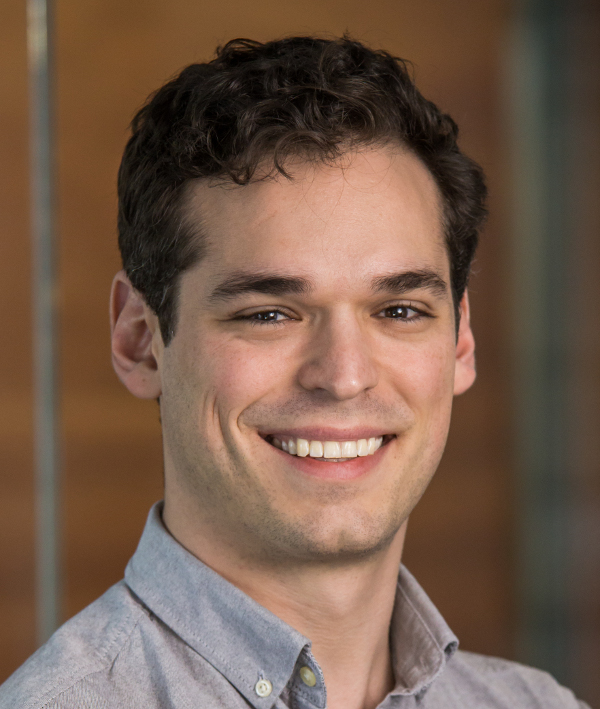 |
Zak Kincaid
I'm an associate professor at Princeton University. Email: zkincaid@cs.princeton.edu Office: Computer Science Building, Room 219 Address: 35 Olden Street, Princeton, NJ 08540 |
news
- "Solvable Polynomial Ideals: The Ideal Reflection for Program Analysis" with John Cyphert to appear in POPL 2024
- "When Less is More: Consequence-finding in a Weak Theory of Arithmetic" with Nicolas Koh and Shaowei Zhu to appear at POPL 2023
- "Reflections on Termination of Linear Loops" with Shaowei Zhu to appear at CAV 2021
- Tom Reps and I will deliver a tutorial on algebraic program analysis at CAV 2021
- "Termination Analysis without the Tears" with Shaowei Zhu to appear at PLDI 2021
research
My main research interests are in program analysis, logic, and programming languages. I have active research projects that aim to make program analysis compositional and robust.selected publications (full list at dblp)
|
Solvable Polynomial Ideals: The Ideal Reflection for Program Analysis with John Cyphert. POPL 2024.
This paper presents a program analysis method that generates program
summaries involving polynomial arithmetic. Our approach builds on
prior techniques that use solvable polynomial maps for summarizing
loops. These techniques are able to generate all polynomial
invariants for a restricted class of programs, but cannot be applied
to programs outside of this class—for instance, programs with nested
loops, conditional branching, unstructured control flow, etc. This
paper shows how these techniques can be applied to generate polynomial
invariants for loops with arbitrary control flow while retaining
the
|
 |
|
When Less is More: Consequence-finding in a Weak Theory of Arithmetic
with Nicolas Koh and Shaowei Zhu. POPL 2023.
This paper presents a theory of non-linear integer/real arithmetic and algorithms for reasoning about this theory. The theory can be conceived of as an extension of linear integer/real arithmetic with a weakly-axiomatized multiplication symbol, which retains many of the desirable algorithmic properties of linear arithmetic. In particular, we show that the conjunctive fragment of the theory can be effectively manipulated (analogously to the usual operations on convex polyhedra, the conjunctive fragment of linear arithmetic). As a result, we can solve the following consequence-finding problem: given a ground formula F, find the strongest conjunctive formula that is entailed by F. As an application of consequence-finding, we give a loop invariant generation algorithm that is monotone with respect to the theory and (in a sense) complete.
|
 |
|
Reflections on Termination of Linear Loops
with Shaowei Zhu. CAV 2021.
This paper shows how techniques for linear dynamical systems can be used to reason about the behavior of general loops. We present two main results. First, we show that every loop that can be expressed as a transition formula in linear integer arithmetic has a best model as a deterministic affine transition system. Second, we show that for any linear dynamical system f with integer eigenvalues and any integer arithmetic formula G, there is a linear integer arithmetic formula that holds exactly for the states of F for which G is eventually invariant. Combining the two, we develop a monotone conditional termination analysis for general loops.
|
 |
|
Termination Analysis Without the Tears
with Shaowei Zhu. PLDI 2021.
Termination is undecidable, and so algorithms for termination analysis typically either (1) provide strong behavior guarantees, but work in limited circumstances or (2) are broadly applicable, but have weak behavior guarantees. This paper presents ComPACT, a practical termination analysis that is both compositional (the result of analyzing a composite program is a function of the analysis results of its components) and monotone (“more information into the analysis yields more information out”). The key contributions are (1) an extension of Tarjan's method for solving path problems in graphs to solve infinite path problems and (2) a collection of monotone conditional termination analyses based on this framework. We demonstrate that our tool ComPACT is competitive with state-of-the-art termination tools while providing stronger behavioral guarantees.
|
 |
|
Templates and Recurrences: Better Together
with Jason Breck, John Cyphert, and Tom Reps. PLDI 2020.
Two prominent approaches to generating numerical program
invariants are templated-based methods, which reduce
invariant generation to constraint solving by fixing a
template invariant and solving for the unknowns,
and recurrence-based methods, which compute invariants
by extracting recurrence relations from code and computing
their closed forms. In this paper, we combine these two
approaches and obtain a technique that overcomes some of the
limitations of each. It uses templates in which the unknowns
are functions rather than numbers, and the constraints on the
unknowns are recurrences. The technique synthesizes invariants
involving polynomials, exponentials, and logarithms, even in
the presence of complex control-flow, including any
combination of loops, branches, and (possibly non-linear)
recursion.
|
 |
|
Loop Summarization with Rational Vector Addition Systems
with Jake Silverman. CAV 2019.
This paper presents a technique for computing numerical loop
summaries. The method synthesizes a rational vector addition
system with resets (Q-VASR) that simulates the action of an
input loop, and then uses the reachability relation of that
Q-VASR to over-approximate the behavior of the loop. The key
technical problem solved in this paper is to automatically
synthesize a Q-VASR that is a best abstraction of a given loop
in the sense that (1) it simulates the loop and (2) it is
simulated by any other Q-VASR that simulates the loop. Since
our loop summarization scheme is based on computing the exact
reachability relation of a best abstraction of a loop, we can
make theoretical guarantees about its behavior. Moreover, we
show experimentally that the technique is precise and
performant in practice.
|
 |
|
A Practical Algorithm for Structure
Embedding
with Charlie
Murphy. VMCAI 2019.
This paper presents an algorithm for the structure
embedding problem: given two finite first-order structures
over a common relational vocabulary, does there exist an
injective homomorphism from one to the other? The structure
embedding problem is NP-complete in the general case, but for
monadic structures (each predicate has arity at most 1) we
observe that it can be solved in polytime by reduction to
bipartite graph matching. Our algorithm, MatchEmbeds, extends
the bipartite matching approach to the general case by using
it as the foundation of a backtracking search procedure. We
show that MatchEmbeds outper- forms state-of-the-art SAT, CSP,
and subgraph isomorphism solvers on difficult random instances
and significantly improves the performance of a client model
checker for multi-threaded programs.
|
 |
|
Closed Forms for Numerical Loops
with Jason Breck, John Cyphert, and Tom Reps. POPL 2019.
This paper investigates the problem of reasoning about
non-linear behavior of simple numerical loops. Our approach
builds on classical techniques for analyzing the behavior of
linear dynamical systems. It is well-known that a closed-form
representation of the behavior of a linear dynamical system
can always be expressed using algebraic numbers, but this
approach can create formulas that present an obstacle for
automated-reasoning tools. This paper characterizes when
linear loops have closed forms in simpler theories that are
more amenable to automated reasoning. The algorithms for
computing closed forms described in the paper avoid the use of
algebraic numbers, and produce closed forms expressed using
polynomials and exponentials over rational numbers. We show
that the logic for expressing closed forms is decidable,
yielding decision procedures for verifying safety and
termination of a class of numerical loops over rational
numbers. We also show that the procedure for computing closed
forms for this class of numerical loops can be usedxc to
over-approximate the behavior of arbitrary numerical programs
(with unrestricted control flow, non-deterministic
assignments, and recursive procedures).
|
 |
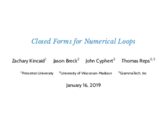 Slides |
|
Refinement of Path Expressions for Static Analysis
with John Cyphert, Jason Breck, and Tom Reps. POPL 2019.
Algebraic program analyses compute information about a
program's behavior by first (a) computing a valid path
expression and then (b) interpreting the path expression in a
semantic algebra that defines the analysis. There are an
infinite number of different regular expressions that qualify
as valid path expressions, which raises the question: which
one should we choose? While any choice yields a sound result,
for many analyses the choice can have a drastic effect on the
precision of the results obtained.
In this paper, we develop an algorithm that takes as input a
valid path expression E, and returns a valid path expression E'
that is guaranteed to yield analysis results that are at
least as good as those obtained using E.
|
 |
|
Numerical Invariants via Abstract Machines. Invited talk at SAS 2018.
This talk presents an overview of a line of recent work on
generating non-linear numerical invariants for loops and
recursive procedures. The method is compositional in the sense
that it operates by breaking the program into parts, analyzing
each part independently, and then combining the results. The
fundamental challenge is to devise an effective method for
analyzing the behavior of a loop given the results of
analyzing its body. The key idea is to separate the problem
into two: first we approximate the loop dynamics by an
abstract machine, and then symbolically compute the
reachability relation of the abstract machine.
|
 |
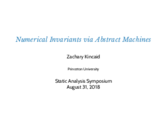 Slides |
|
Non-Linear Reasoning For Invariant Synthesis
with Jason Breck, John Cyphert, and Tom Reps. POPL 2018.
An appealing approach to non-linear invariant generation is to exploit
the powerful recurrence-solving techniques that have been developed in
the field of computer algebra. However, there is a gap between the
capabilities of recurrence solvers and the needs of program analysis:
(1) loop bodies are not merely systems of recurrence relations---they
may contain conditional branches, nested loops, non-deterministic
assignments, etc., and (2) a client program analyzer must be able to
reason about the closed-form solutions produced by a recurrence solver
(e.g., to prove assertions). This paper presents a method for
generating non-linear invariants for general loops by analyzing
recurrence relations. The key components are an abstract domain for
reasoning about non-linear arithmetic, a semantics-based method for
extracting recurrence relations from loop bodies, and a recurrence
solver that avoids closed forms that involve complex or irrational
numbers.
|
 |
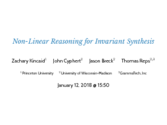 Slides |
|
Strategy Synthesis for Linear Arithmetic Games
with Azadeh Farzan. POPL 2018.
This paper studies the strategy synthesis problem for games defined
within the theory of linear rational arithmetic. Two types of games
are considered. A satisfiability game, described by a
quantified formula, is played by two players that take turns
instantiating quantifiers. The objective of each player is to prove
(or disprove) satisfiability of the formula. A reachability
game, described by a pair of formulas defining the legal moves of
each player, is played by two players that take turns choosing
positions---rational vectors of some fixed dimension. The objective
of each player is to reach a position where the opposing player has no
legal moves (or to play the game forever). We give a complete
algorithm for synthesizing winning strategies for satisfiability games
and a semi-algorithm for synthesizing winning strategies for
reachability games.
|
 |
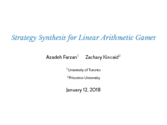 Slides |
|
A Symbolic Decision Procedure for Symbolic Alternating Automata
with Loris D'Antoni, and Fang Wang. MFPS 2017.
We introduce Symbolic Alternating Finite Automata (s-AFA) as a
succinct and decidable model for describing sets of finite sequences
over arbitrary alphabets. Boolean operations over s-AFAs have linear
complexity, which contrasts the quadratic cost of intersection and
union for non-alternating symbolic automata. Due to this succinctness,
emptiness and equivalence checking are PSpace-hard. We introduce an
algorithm for checking the equivalence of two s-AFAs based on
bisimulation up to congruence. This algorithm exploits the power of
SAT solvers to efficiently search the state space of the s-AFAs.
|
 |
|
Compositional Recurrence Analysis Revisited
with Jason Breck, Ashkan Boroujeni, and Tom Reps. PLDI 2017.
Compositional recurrence analysis (CRA) is a static-analysis method
based on a combination of symbolic analysis and abstract
interpretation. CRA computes the meaning of a procedure following
Tarjan’s path-expression method: first compute a regular expression
recognizing a set of paths through the procedure, then interpret that
regular expression within a suitable semantic algebra. This paper
introduces ICRA, an extension of CRA to recursive procedures. ICRA
overcomes the “impedance mismatch” between CRA, which relies on
representing program paths with regular languages, and the
context-free-language underpinnings of context-sensitive analysis.
|
 |
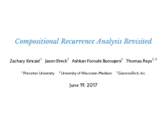 Slides |
|
Linear Arithmetic Satisfiability via Strategy Improvement
with Azadeh Farzan. IJCAI 2016.
This article presents a decision procedure for the theory of linear
rational arithmetic (and linear integer arithmetic), including
quantifiers. The algorithm is based on synthesizing winning
strategies for quantified formulas (interpreted as satisfiability
games) by mutual strategy improvement.
|
 |
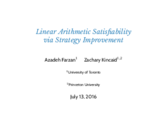 Slides |
|
Proving Liveness of Parameterized Programs
with Azadeh Farzan and Andreas Podelski.
LICS 2016.
Correctness of multi-threaded programs typically requires that they
satisfy liveness properties. For example, a program may require that
no thread is starved of a shared resource, or that all threads
eventually agree on a single value. This paper presents a method for
proving that such liveness properties hold. Two particular challenges
addressed in this work are that (1) the correctness argument may rely
on global behaviour of the system (e.g., the correctness argument may
require that all threads collectively progress towards "the good
thing" rather than one thread progressing while the others do not
interfere), and (2) such programs are often designed to be executed by
any number of threads, and the desired liveness properties must hold
regardless of the number of threads that are active in the program.
|
 |
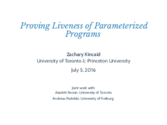 Slides |
|
Compositional Recurrence Analysis
with Azadeh Farzan. FMCAD 2015.
This paper presents a new method for automatically generating
numerical invariants for imperative programs. The procedure computes a
transition formula which over-approximates the behaviour of a given
input program. It is compositional in the sense that it operates by
decomposing the program into parts, computing a transition formula for
each part, and then composing them. Transition formulas for loops are
computed by extracting recurrence relations from a transition formula
for the loop body and then computing their closed forms.
Experimentation demonstrates that this method is competitive with
leading verification techniques.
|
 |
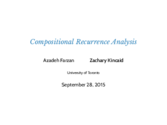
Slides |
|
Spatial Interpolants
with Aws Albarghouthi,
Josh Berdine, and
Byron Cook.
ESOP 2015.
We propose SplInter, a new technique for proving properties of
heap-manipulating programs that marries (1) a new separation
logic-based analysis for heap reasoning with (2) an
interpolation-based technique for refining heap-shape invariants
with data invariants. SplInter is property
directed, precise, and produces counterexample traces when a
property does not hold. Using the novel notion of spatial
interpolants modulo theories, SplInter can infer complex invariants
over general recursive predicates, e.g., of the form "all elements in
a linked list are even" or "a binary tree is sorted."
|
 |
|
Proof Spaces for Unbounded Parallelism
with Azadeh Farzan and Andreas Podelski.
POPL 2015.
In this paper, we describe proof spaces, a proof system for verifying
safety properties for multi-threaded programs in which the number of
executing threads is not statically bounded. Our development of this
proof system is motivated by the question of how to generalize a proof
of correctness (perhaps obtained from a verifier for sequential
programs) of a some finite set of example traces so that the
correctness argument applies to all traces of the program. We show
that proof spaces are complete relative to the inductive assertion
method, and give algorithms for automating them.
|
 |
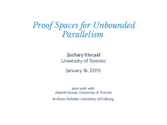
Slides |
|
Consistency Analysis of Decision-Making Programs
with Swarat Chaudhuri
and Azadeh Farzan.
POPL 2014.
Applications in many areas of computing make discrete decisions under
uncertainty; for example, the application may rely on limited
numerical precision in input, or on input or sensory data. While an
application executing under uncertainty cannot be relied upon to make
decisions which are correct with respect to a given world, it is
desirable that their decisions are at least consistent (i.e.,
correct with respect to some possible world). This paper
presents a sound, automatic program analysis for verifying program
consistency.
|
 |
|
Proofs that count
with Azadeh Farzan and Andreas Podelski.
POPL 2014.
Counting arguments are among the most basic methods of proof in
mathematics. Within the field of formal verification, they are useful
for reasoning about programs with infinite control, such as
programs with an unbounded number of threads, or (concurrent) programs
with recursive procedures. While counting arguments are common in
informal, hand-written proofs of such programs, there are no fully
automated techniques to construct counting arguments. The key
questions involved in automating counting arguments are: how to
decide what should be counted?, and how to decide when a
counting argument is valid? In this paper, we present a technique
for automatically constructing and checking counting arguments, which
includes novel solutions to these questions.
|
 |
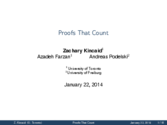
Slides |
|
Symbolic Optimization with SMT solvers
with
Yi Li,
Aws Albarghouthi,
Arie Gurfinkel
and Marsha Chechik.
POPL 2014.
The rise in efficiency of Satisfiability Modulo Theories (SMT) solvers
has created numerous uses for them in programming languages: software
verification, program synthesis, functional programming, refinement
types, etc. SMT solvers are effective at finding arbitrary satisfying
assignments for formulae, but for some applications it is necessary to
find an assignment that optimizes (minimizes/maximizes) certain
criteria. We present an efficient SMT-based optimization algorithm for
objective functions in the theory of linear real arithmetic.
|
 |
|
Duet: static analysis for unbounded parallelism
with Azadeh Farzan.
CAV 2013.
Duet is a static analysis tool
for concurrent programs in which the number of executing threads is not
statically bounded. It has a modular architecture, which is based on
separating the invariant synthesis problem in two subtasks: (1) data
dependence analysis, which is used to construct a data flow model of
the program, and (2) interpretation of the data flow model over a
(possibly infinite) abstract domain, which generates invariants. This
separation of concerns allows researchers working on data dependence
analysis and abstract domains to combine their efforts toward solving
the challenging problem of static analysis for unbounded concurrency.
|
 |
|
Recursive program synthesis
with Aws Albargouthi and Sumit Gulwani.
CAV 2013.
Program synthesis from input-output examples has the power of extending
the range of computational tasks achievable by end-users who have no
programming knowledge, but can articulate their desired computations by
describing input-output behaviour. In this paper we present Escher, an
algorithm that interacts with the user via input-output examples to
synthesize recursive programs. Escher is parameterized by the
components that can be used in the program, thus providing a generic
synthesis algorithm that can be instantiated to suit different domains.
Escher adopts a novel search strategy through the space of programs
that utilizes special datastructures for inferring conditionals and
synthesizing recursive procedures.
|
 |
|
Inductive data flow graphs
with Azadeh Farzan and Andreas Podelski.
POPL 2013.
We propose inductive data flow graphs, data flow graphs with
incorporated inductive assertions, as the basis of an approach to
verifying concurrent programs. An inductive data flow graph accounts
for a set of dependencies between program events, and therefore stands
as a representation for the set of executions which give rise to these
dependencies. By representing information about dependencies rather
than control flow, inductive data flow graphs can yield very succinct
proofs. Our strategy for verifying concurrent programs defers
reasoning about control to the proof checking step, a purely
combinatorial problem, thus avoiding the need to reason about data and
control simultaneously.
|
 |
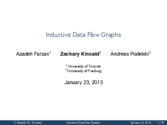
Slides |
|
Verification of parameterized concurrent programs by modular reasoning about data and control
with Azadeh Farzan.
POPL 2012.
We consider the problem of verifying thread-state properties of
multithreaded programs in which the number of active threads cannot be
statically bounded. Our approach is based on decomposing the task into
two modules, where one reasons about data and the other reasons about
control. The two modules are incorporated into a feedback loop, so
that the abstractions of data and control are iteratively coarsened as
the algorithm progresses (that is, they become weaker) until a fixed
point is reached.
This version fixes some typographical errors that appeared in the printed version - thanks to Chinmay Narayan, Suvam Mukherjee, and Deepak D'Souza for finding them. |
 |
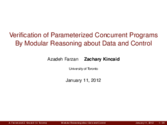
Slides |
|
Compositional bitvector analysis for concurrent programs with nested locks with Azadeh Farzan. SAS 2010.
We propose a new technique for bitvector data flow analysis for
concurrent programs. Our algorithm works for concurrent programs that
synchronize via nested locks. We give a compositional algorithm that
first computes thread summaries and then efficiently combines them to
solve the dataflow analysis problem. We show that this algorithm
computes precise solutions (meet over all paths) to bitvector problems.
|
 |
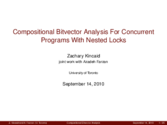
Slides |
teaching
Fall 2021 - COS 516 / ELE 516: Automated Reasoning about SoftwarePast:
- Fall 2023 - COS IW 10: Practical Solutions to Intractable Problems
- Spring 2023 - COS IW 04: Practical Solutions to Intractable Problems
- Spring 2022 - COS 320: Compiling techniques
- Spring 2020 - COS 320: Compiling techniques
- Spring 2019 - COS 320: Compiling techniques
- Fall 2018 - COS 516 / ELE 516: Automated Reasoning about Software
- Spring 2018 - COS IW 06: Little Languages and COS IW 07: Practical Solutions to Intractable Problems
- Spring 2017 - COS IW 08: Practical solutions to intractable problems.
- Fall 2016 - COS 597D: Reasoning about concurrent systems.
students
- Jake Silverman
- Shaowei Zhu
- Nicolas Koh
- Nikhil Pimpalkhare
- Charlie Murphy (PhD 2023, Postdoc at University of Wisconsin--Madison)
activities
- PLDI 2022: Program Committee.
- POPL 2021: Program Committee.
- CAV 2020: Program Committee.
- PLDI 2020: External Review Committee.
- POPL 2019-2020: Workshop co-chair.
- OBT 2018: Program Committee.
- CAV 2018: Program Committee.
- VSTTE 2017: Program Committee.
- CAV 2017: Program Committee.
- PLDI 2017: Program Committee.
- POPL 2017: Program Committee.
- CAV 2016: Workshop chair/Program Committee.
- PLDI 2016: External Review Committee.
- TACAS 2016: Program Committee.
- SSS 2015: Program Committee
- Tiny Transactions on Computer Science vol. 3.: Program Committee
- PLDI 2014: Artifact Evaluation Committee
the rest
- Slides for POPL'18 tutorial on algebraic program analysis:
background | intraprocedural analysis | interprocedural analysis | iteration domains - I received my PhD from the University of Toronto. My adviser was Azadeh Farzan.
- Some of my work is implemented in the Duet program analyzer.
- My Erdős number is 3.
- Chinmay Narayan has typeset a FAQ for our POPL12 paper.